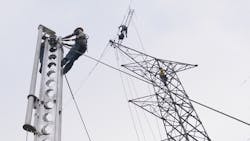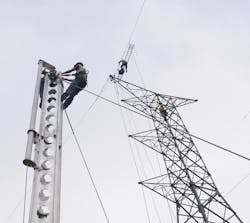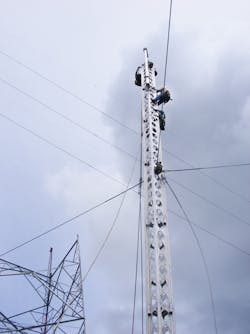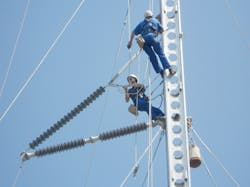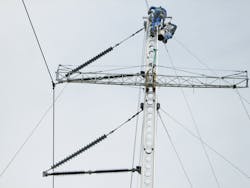Rescue Structures Speed Restoration
TERNA, the transmission system operator in Italy, is currently ranked seventh in the world in terms of transmission system length. In addition to ownership of the majority of the country’s transmission system, TERNA is responsible for the design, construction and operations that extends 62,000 km (38,525 miles). To maintain a secure, reliable and cost-effective supply of electrical energy in Italy, the system is interconnected with 18 circuits in neighboring countries, which form the European transmission system (ENTSTO-E).
A further strategy to ensure a reliable flow of energy is to minimize the impact of power outages by reducing the number, frequency and duration of such events, which is a daunting challenge. Power outages are unpredictable and can be caused by many weather-related factors. Events such as ice storms, thunderstorms and high winds are responsible for a large percentage of power outages in Italy and in most parts of the world.
Power outages can last from a few minutes to many days, depending on the severity of damage. When such an event occurs, the utility’s emergency-response teams are summoned to duty to repair the damage and restore supplies as quickly as possible. This task often can be difficult, resulting in teams working in demanding and dangerous conditions. Apart from inconvenience to the customer, these disruptive events have a financial impact on the utility. In addition to the cost of the emergency-response teams and system fault repairs, outages also result in a loss of revenue and may even require the utility to pay penalties imposed by industry regulators for the number and length of supply interruptions.
Annually, TERNA undertakes an exhaustive planning procedure to prepare the national transmission grid development plan. This formal document establishes a rolling 10-year planning horizon for the utility’s transmission system, specifying the goals and objectives to be achieved within the planning horizon. One of the key objectives in TERNA’s plan is to cope with system emergencies to effectively deliver and improve system reliability. TERNA’s aim is to improve its response to emergency situations created by system outages, so that it can address these events rapidly and more effectively.
Transmission Tower Solution
The Italian topography and high hydrogeological risks can cause the failure of the transmission line’s supporting towers, and one solution is for TERNA to stockpile spare tower parts to ensure rapid deployment. However, this solution is not considered practical or cost-effective because it would require TERNA to store many tower types and a large number of components.
An alternative and more expedient solution is a temporary tower, specially designed for quick installation, offering a lightweight, durable and versatile solution. These towers can be delivered to any site and erected within a couple of hours using minimal equipment, without the need for detailed site engineering.
A temporary tower enables the faulted transmission line to be repaired and reenergized, providing the utility the opportunity to plan and rebuild the tower at the most convenient time, without an extended supply interruption. During the permanent reconstruction work, the conductors are transferred to the new tower, allowing the temporary tower to be dismantled and the components returned to their storage containers to await the next emergency.
Temporary towers are not only used for tower failures, they also can be used on routine maintenance work when towers need to be replaced or repositioned. Additional applications include their use as temporary structural supports, such as a transmission line bypass of a construction site.
Tower Selection
Following detailed studies, TERNA decided to invest in an inventory of temporary towers as part of its emergency-
response strategy. A selection process for acquiring such a tower system and identifying potential suppliers was conducted to identify the tower system that would be the most compatible to comply with all applicable certification requirements.
For TERNA, this meant satisfying the standards of Italian and European legislation as well as its stringent internal standards. Included in the planned international bidding process to select the product supplier, the towers of the successful bidder also would need to satisfy the field trials specified by the transmission system operator’s engineers. As a result of the competitive bidding process, TERNA awarded its contract to supply temporary towers to Tower Solutions.
Design of the Temporary Tower
The Tower Solutions tower has a foundation plate that can be placed on almost any ground profile, even on an inclined surface. By employing the expandable plate option for soft-soil applications, the contact with ground can be increased up to four times the area of the standard plate. This is an important feature for TERNA as its transmission lines pass through many different kinds of terrain; therefore, it was necessary to select a tower that would be adaptable to a wide range of ground conditions. The design included several specific design features:
- An advanced articulation component was made of a special alloy able to support the full weight of the tower, making tower movement during installation, removal and handling easier while minimizing the wear on the galvanized finish.
- The design of the individual sections measured 460 mm by 460 mm (18.11 inches by 18.11 inches) in rectangular cross section and 2,580 mm (101.57 inches) in length, weighing 126 kg (278 lb). TERNA’s field personnel appreciated these relatively light sections because they made tower erection noticeably easier.
- The higher strength-to-weight ratio and the tower’s versatility in adapting to many alternative configuration requirements made this tower the preferred option for the many wide-ranging challenges that TERNA can encounter when responding to unpredictable emergency situations. The higher strength of the tower section also means fewer guy wires are necessary, a major advantage when time is of the essence. It also enables the support of taller and longer overhead line spans.
- All emergency towers use attachment plates for securing insulators and guy wires to the tower. TERNA considered the tower selected offered the easiest and simplest design, requiring only one universal attachment plate component for all guy wires, suspension insulators and post insulators. This component, which can be installed anywhere on the tower, also allows the insulator to swivel both horizontally and vertically. This ensures the insulator will always remain in either a compression or tension mode, and never in a bending mode, which is the weakest for an insulator.
- The Tower Solutions tower is packaged, delivered and stored in specially modified marine containers together with all the hardware and tower sections, stored in a pattern that makes maximum use of the space available inside the container, allowing for easy removal and easy repacking of the tower components. The storage capacity of a 6-m (20-ft) container accommodates two complete 44-m (144-ft) tower assemblies (34 sections in total) including all hardware, bases and articulation components, excluding insulator hardware.
Testing Regime
Tower Solutions towers satisfy the IEEE 1070 standard in North America, but, in the absence of a European qualification and to comply with the conditions of the contract with TERNA, the towers had to satisfy additional testing requirements:
- IEC 60652 standards (loading tests on overhead line structures) to qualify the towers for European applications
- TERNA’s SpA technical specification UX LS1014, CEI 11-4: technical standards for the design and operation of the line.
The tower testing program was conducted in accordance with TERNA’s requirements at the testing facilities of DAMP Electric Engenharia, Torres e Ferragens S.A. of Grupo BMG, in Sabara City, Minas Gerais, Brazil. The emergency tower system subjected to testing comprised single-circuit vertical-suspension (flag) configuration, with an overall height 42.2 m (138.5 ft) and consisting of 16 sections. Equipe Industria Comercio e Servico Ltda., an independent company fully certified by the Brazilian government’s National Institute of Metrology, Quality and Technology, supplied load measurement equipment. ALFA Electronicos Ltda. certified all test equipment, which was calibrated on location.
The tower was tested in fully loaded field conditions and all conductor loads were applied directly to the conductor connector area, with wind loads applied directly to the tower structure, which was a vertical-suspension configuration. The tower successfully passed all tests, and based on these excellent results, TERNA purchased four towers.
Emergency Tower Utilization
TERNA immediately took the opportunity to familiarize its engineers and linemen with the towers by having them make preemptive repairs to an aging 150-kV transmission line scheduled for maintenance. In addition to the quick and easy assembly, TERNA’s engineers were impressed by the safety protection afforded by the corner-rail system on the tower combined with the fall arrester, features exclusively designed for Tower Solutions emergency tower system. The fall arrester allows free movement only in the upward direction and, like a seat belt in a car, instantly locks into position if pulled downward, eliminating risk of an accidental fall.
Following the successful completion of the scheduled maintenance project, TERNA decided the emergency-restoration tower was more than an invaluable tool for transmission system emergencies. Subsequently, TERNA ordered an additional 12 towers from Tower Solutions.
Benefits
TERNA is now well equipped to handle any transmission line tower failure and, in addition, has a useful additional tool for maintenance work, which also will significantly reduce the planned outage period. This not only improves system reliability, it also reduces operational costs and, ultimately, electricity tariffs for customers.
Massimo Rebolini ([email protected]) received his Ph.D. degree in electrotechnical engineering at La Sapienza University in Rome, Italy, in 1977. He joined ITALTRAFO in 1978 and held various positions in ENEL before joining TERNA in 2005, where he is now responsible for technologies development. Rebolini has worked on electrical design, analysis of electrical systems, nuclear and thermal power plants, design of extra-high-voltage transmission systems and components for high-voltage dc systems, overhead lines and substations. In addition to publishing several technical papers, Rebolini is the Italian CIGRÉ president.
Alfonso Posati ([email protected]) received his MSME degree at La Sapienza University in Rome, Italy, in 1983. He joined ENEL in 1974 (in the construction department) and TERNA in 1999, where he is now responsible for overhead components development. Posati, who has worked on the electrical and mechanical design of overhead line systems, is a CIGRÉ member and a member of the Italian Electrotechnical Committee.
Giorgio De Donà ([email protected]) received his master’s degree in communication science from the University of Torino in 2003. He joined ENEL in 1981 and then TERNA in 1999, where he is now responsible for conventional and live-line working methods on overhead lines and substations. De Donà is secretary of the Italian Electrotechnical Committee (IEC) TC78, project leader of IEC-TC 78 and convenor of WG11- TC78 for the International Electrotechnical Commission.
Piero Berardi ([email protected]) received his MSME degree from Tor Vergata University in Rome in 2006 and joined the engineering department in TERNA. His primary research interests include structural analysis, overhead line components, design and construction. Berardi is a member of CIGRÉ and the Italian Electrotechnical Committee.
Companies mentioned:
ALFA Electronicos Ltda.| www.alfacomponentes.com.br
INMETRO| www.inmetro.gov.br
TERNA| www.terna.it
Tower Solutions| www.towersolutions.ca
